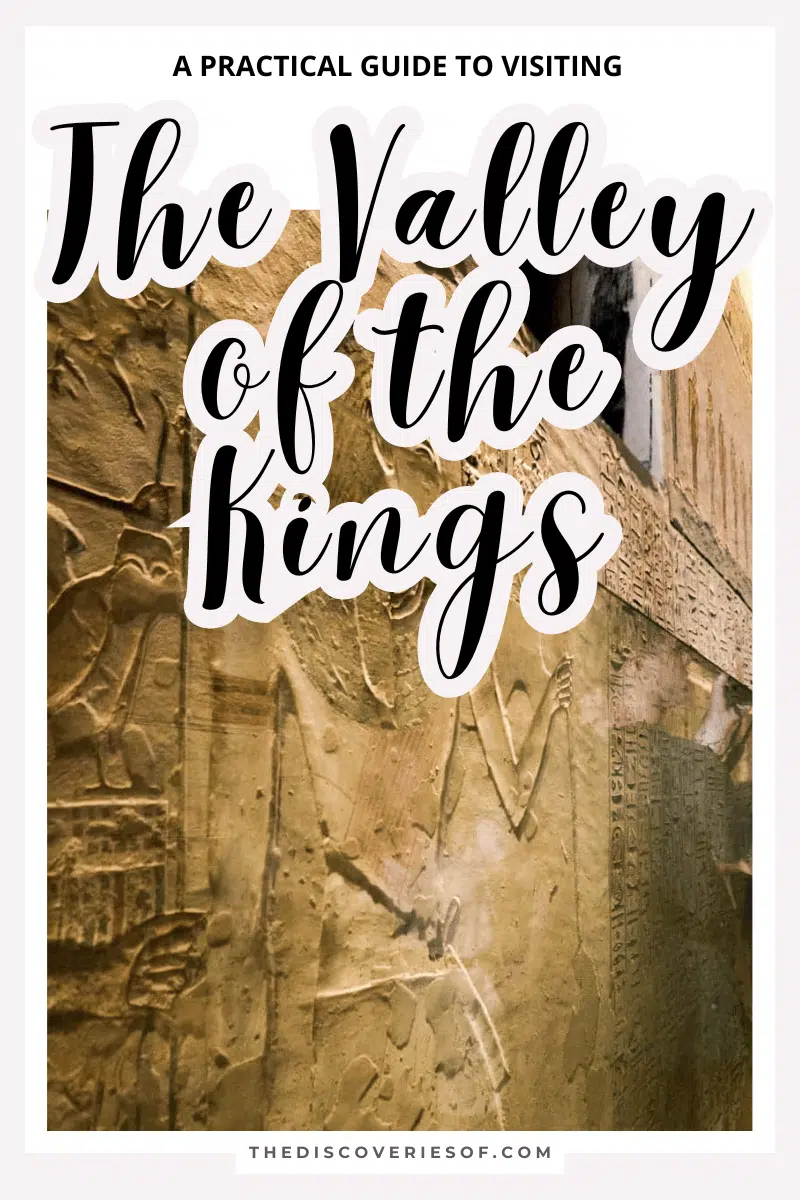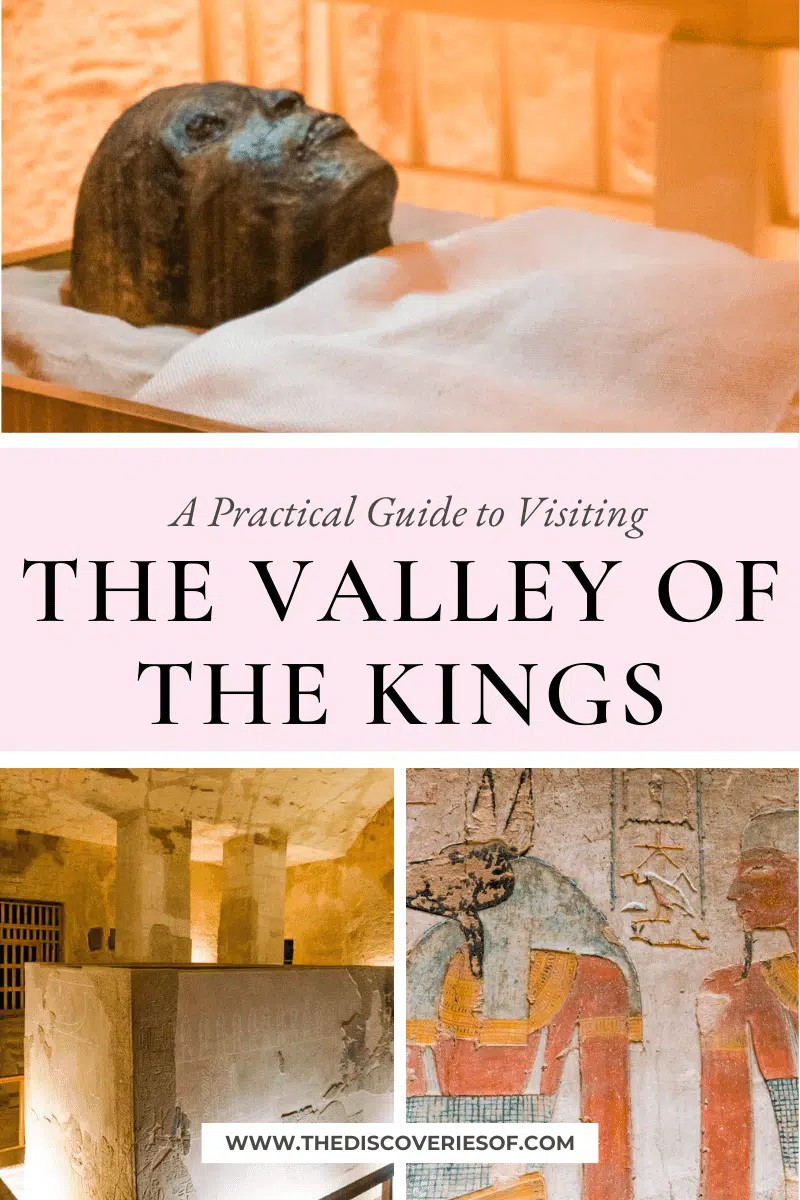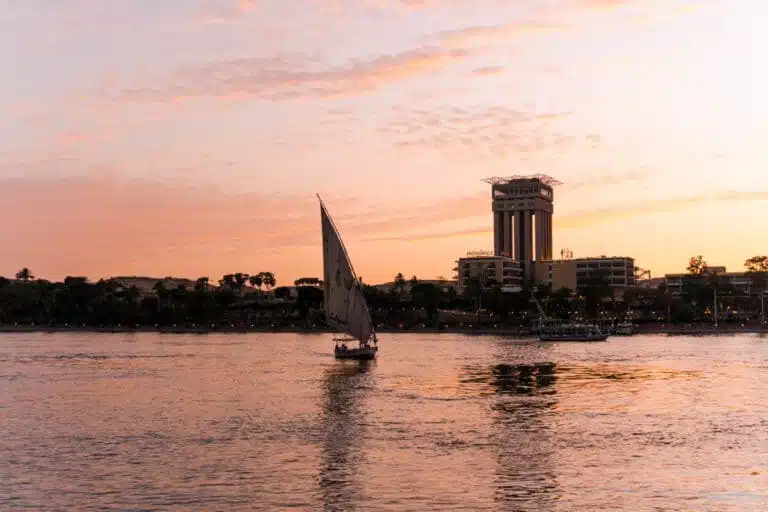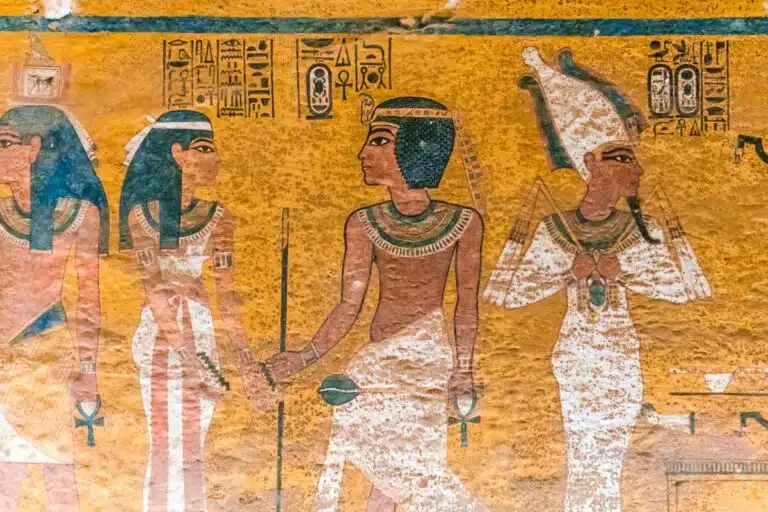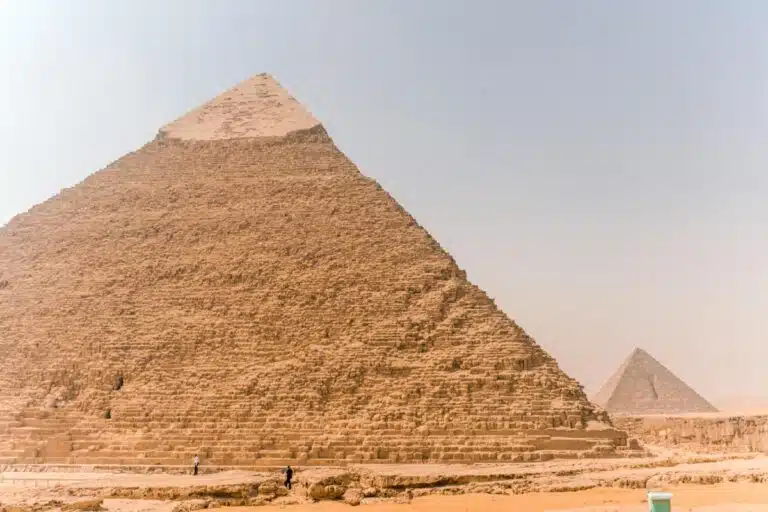The Valley of the Kings is one of Luxor’s stunning attractions. Here’s why you need to visit (and how to plan your trip).
Since the discovery of Tutankhamun’s tomb in 1922, The Valley of the Kings has captured the minds and hearts of travellers worldwide.
This “Gateway to the Afterlife” looks at the ancient Egyptians’ way of life and the burial rituals of their most beloved rulers.
Want to visit the tombs of The Valley of the Kings?
Of course you do! Who wouldn’t want to see the ancient necropolis in which many of Ancient Egypt’s most famous rulers were buried in pomp and splendour?
I have to be honest – visiting the tombs of the Valley of the Kings in Luxor was one of the highlights of my recent Egypt trip – and I know it will be one of yours too.
Stick around to discover my top tips and tricks for visiting this incredible sight. I’m going to cover which tombs you can visit (and which tombs you should visit), the history of the site and how to plan your trip. Let’s go.
Why Visit?
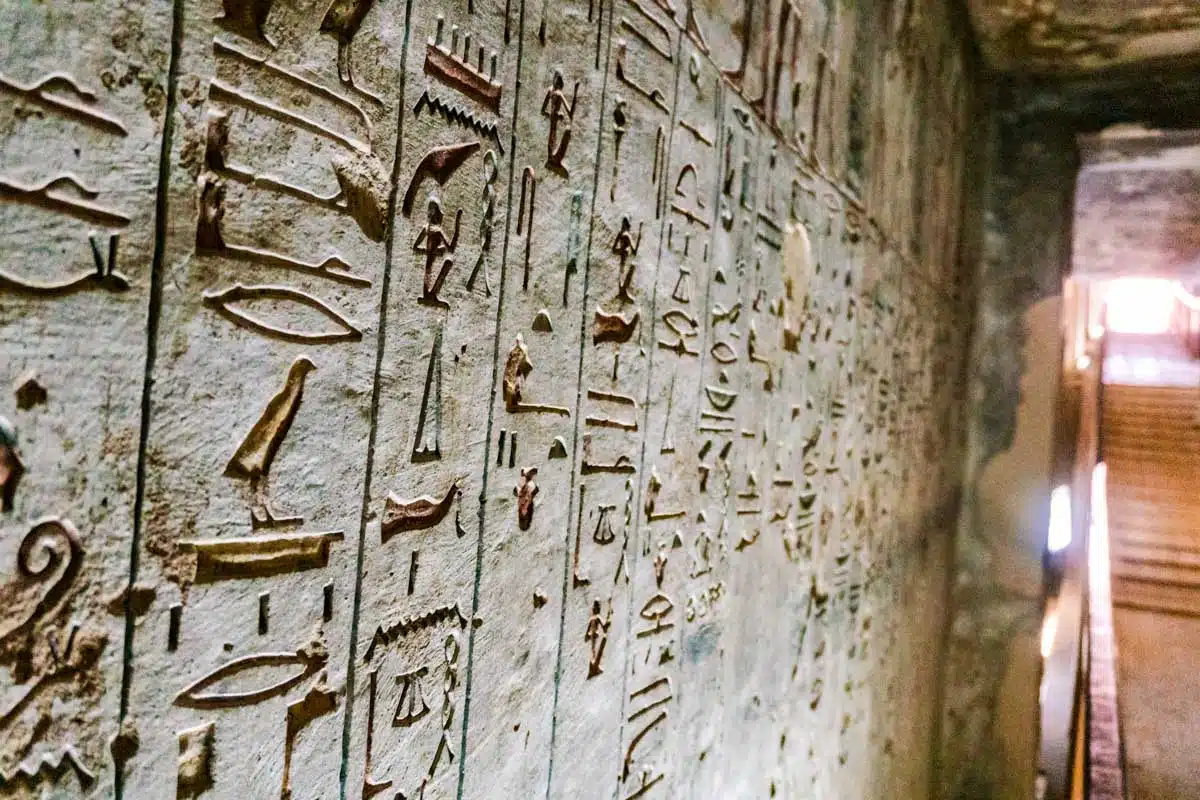
Why wouldn’t you visit the Valley of the Kings is probably a better question!
Along with the Pyramids in Cairo, Karnak and perhaps Abu Simbel, The Valley of the King’s is one of Egypt’s best-known (and most-visited) sights.
In fact, I’d go so far as to say that no trip to Egypt would be complete without visiting The Valley of the Kings.
Top Tip
I would highly recommend taking a guided tour or getting a private guide for your trip to the Valley of the Kings. Although there is information outside each tomb, a guide will really help the stories of the pharaohs and their tombs come to life. Mine certainly did.
What is The Valley of the Kings and Why Does it Exist?
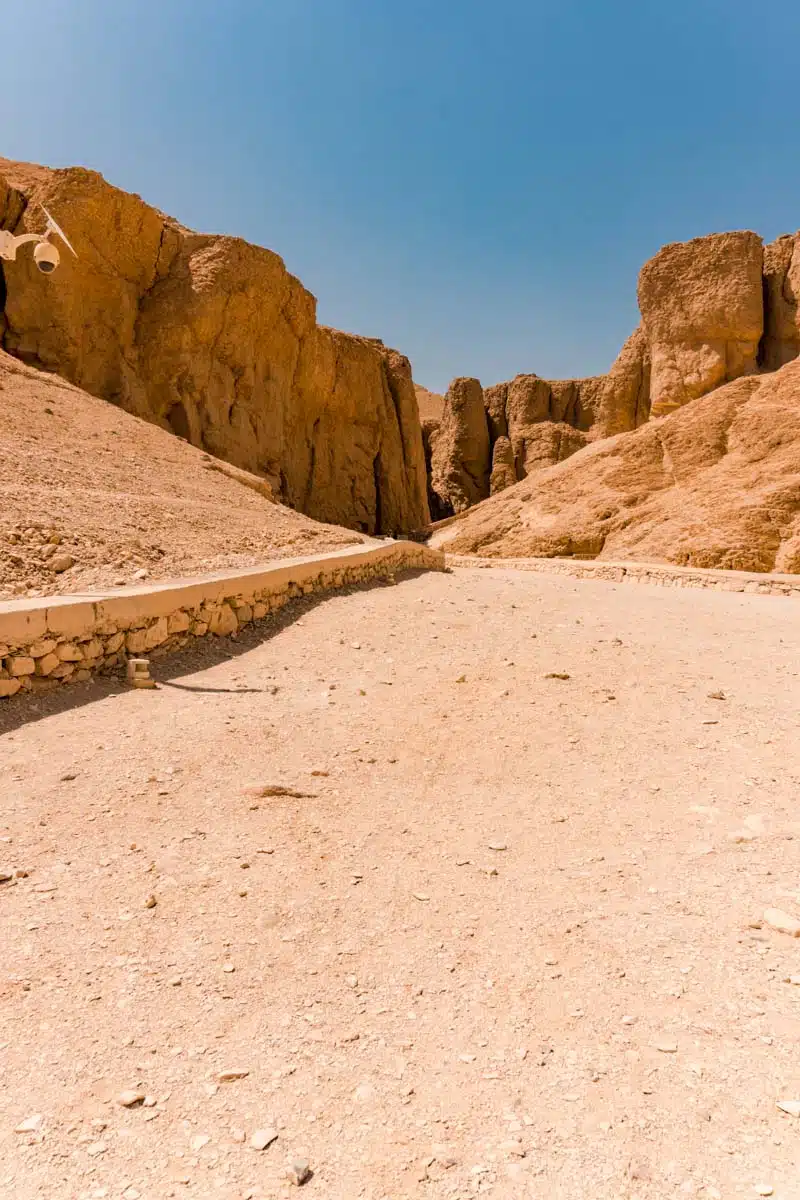
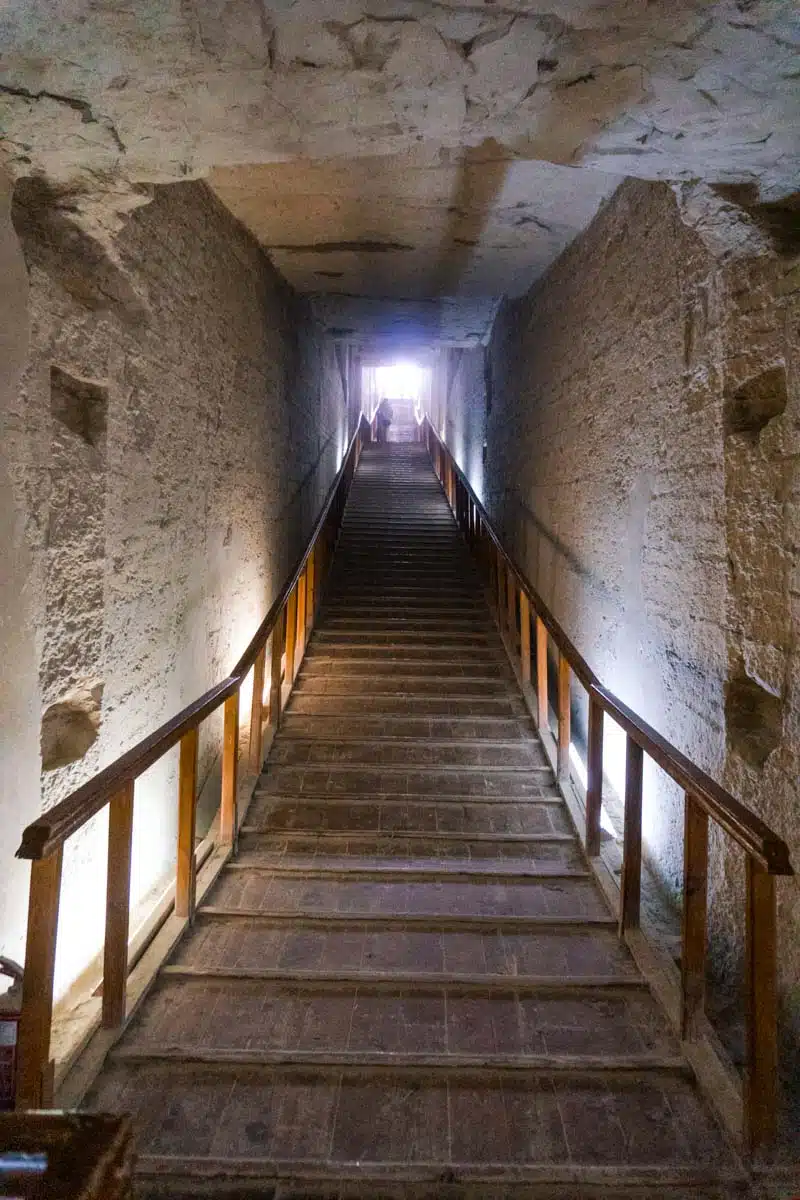
I will delve deeper into the history of the necropolis further on in this guide, but what is the Valley of the Kings and why does it exist?
The Valley of the Kings is a burial ground where pharaohs (and a few nobles) from the 18th, 19th and 20th dynasties were buried.
To understand the Valley of the Kings, you have to know a smidgen about the Ancient Egyptians themselves.
The The Gateway to the Afterlife
Ancient Egyptians believed that you had to do certain things to get into the afterlife – one of which was preserving your body whole. Mummifying your body to preserve it for this second life was paramount.
You also had to bring everything you would want or need for the afterlife… so you can see why having a lavish tomb packed with goods and your mummified body might have seemed like a great idea.
While earlier dynasties used pyramids as royal tombs, later dynasties – starting with Pharaoh Tuthmosis, used The Valley of the Kings.
Visiting the tombs is also a fantastic way to discover the craftsmanship and artistry of the ancient Egyptians. You’ll see this through the intricate details in the tombs and the tomb chambers.
The Tombs in The Valley of the Kings
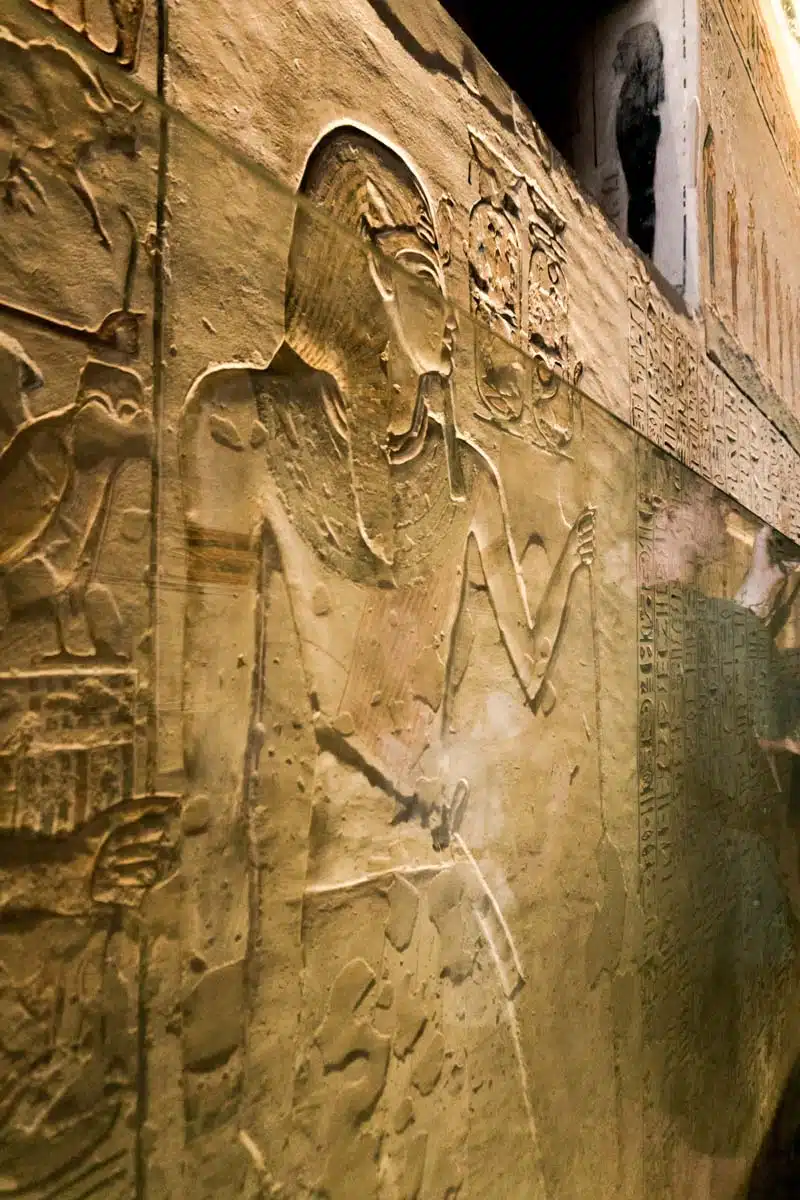
There are 63 tombs in the Valley, although not all are open.
Here’s a quick breakdown of the tombs that are currently open to the public and what you can expect to find in them. I’ve split them into the tombs of the Valley of the Kings included in your general entry ticket and those you have to pay extra to see.
Tombs Included in Your Ticket
The entry ticket to the Valley of the Kings includes entry into three tombs. You have eight tombs to choose from:
- Ramses I
- Ramses IV
- Ramses III
- Ramses IX
- Tausert & Setnakht
- Merneptah
- Seti II
- Siptah
I chose Ramses IX, Merenptah and Tausert & Senakht out of those and will go into more detail below, as well as others recommended to me.
Tausert & Setnakht (KV14)
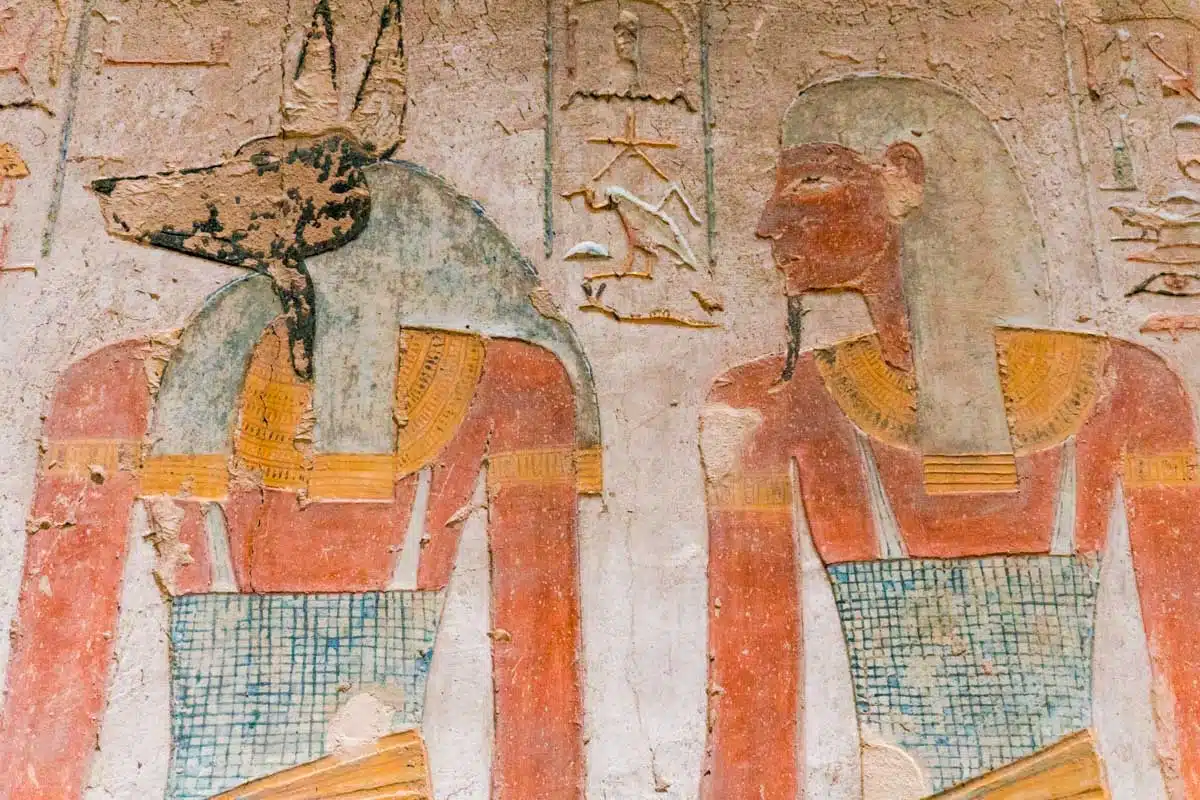
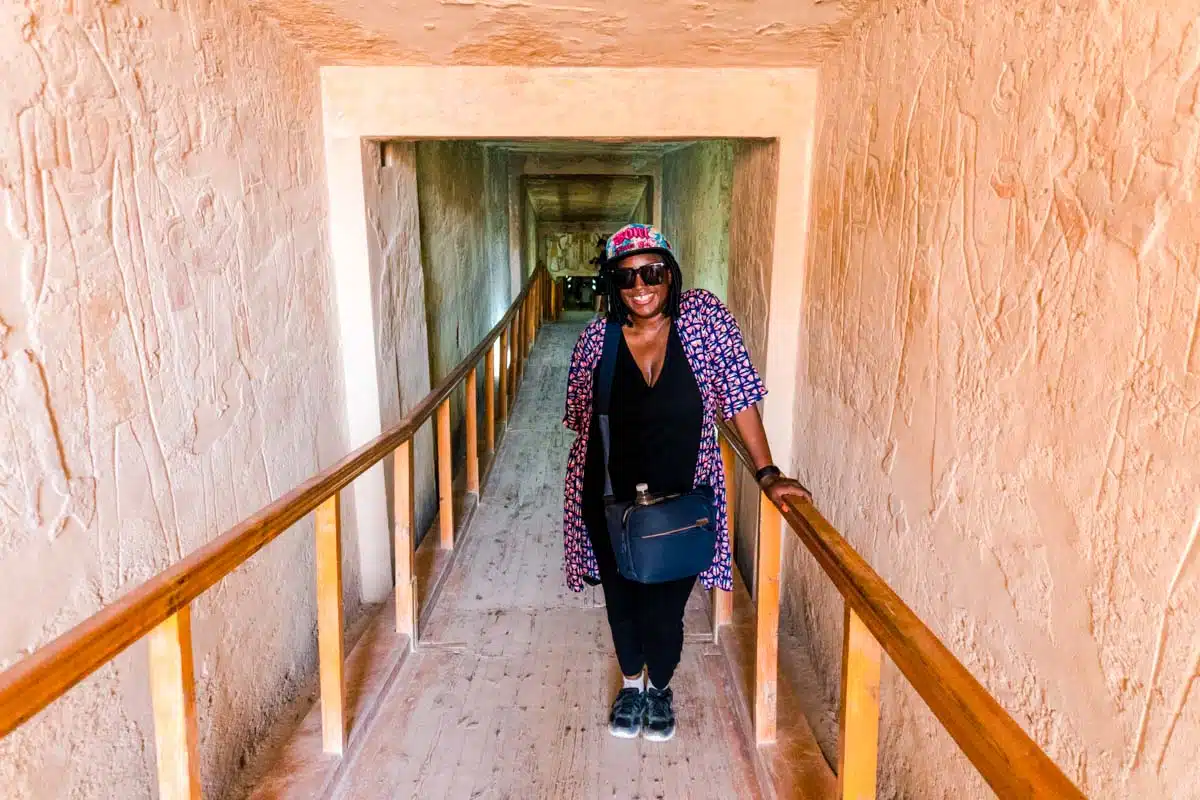
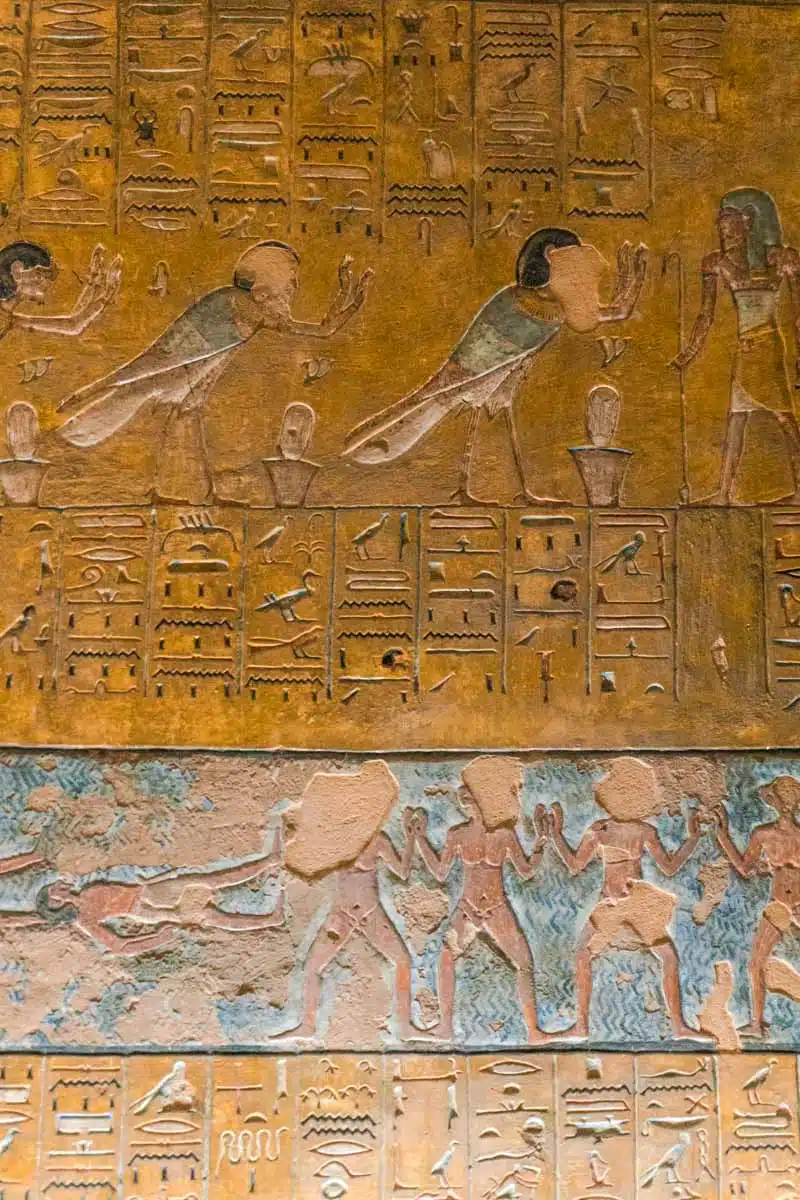
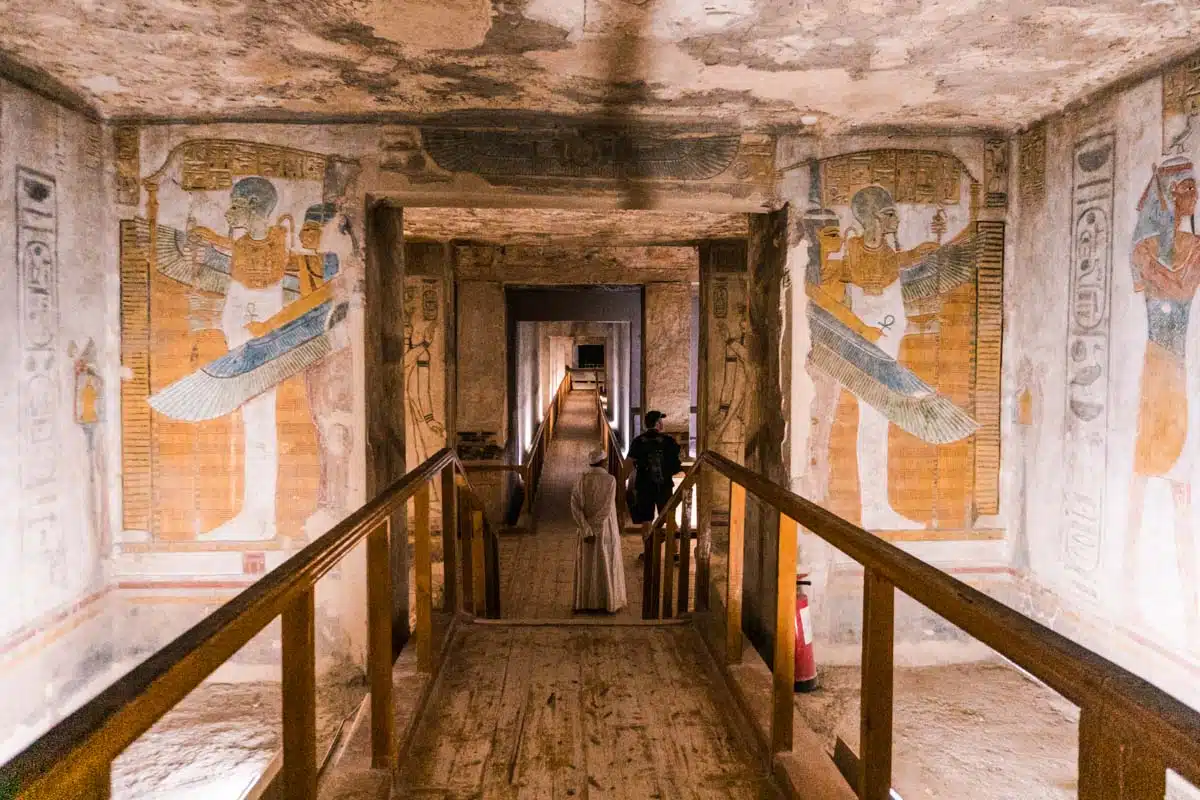
This double tomb is one of the largest in the Valley. It was commissioned for Tausert, Seti II’s wife. She was the last ruler of the 19th dynasty, and she had the tomb built to hold both her and Seti II.
Seti II’s successor, Sethnakht, took over part of the tomb and made it bigger for himself. Inside the tomb, you’ll still get to see Tausert’s burial chamber and images of Tausert and Sethnakht.
Top Tip
Of all the tombs that were included in the general entry ticket, this one was actually my favourite. Unsurprisingly, given the fact it’s a double tomb, it’s really large, but its location at the top of the valley also meant it was the quietest tomb I visited too.
Ramses I (KV16)
Inside Ramses I’s tomb, you’ll find a sloping corridor with a staircase that goes down to his burial chamber. Once there, you’ll find an open red granite coffin decorated with pictures and texts about Ramses.
The walls of the chamber are vividly decorated with inscriptions and paintings. The wall scenes include sections from the Book of the Gates and the king’s Underworld journey.
Ramses IX (KV6)
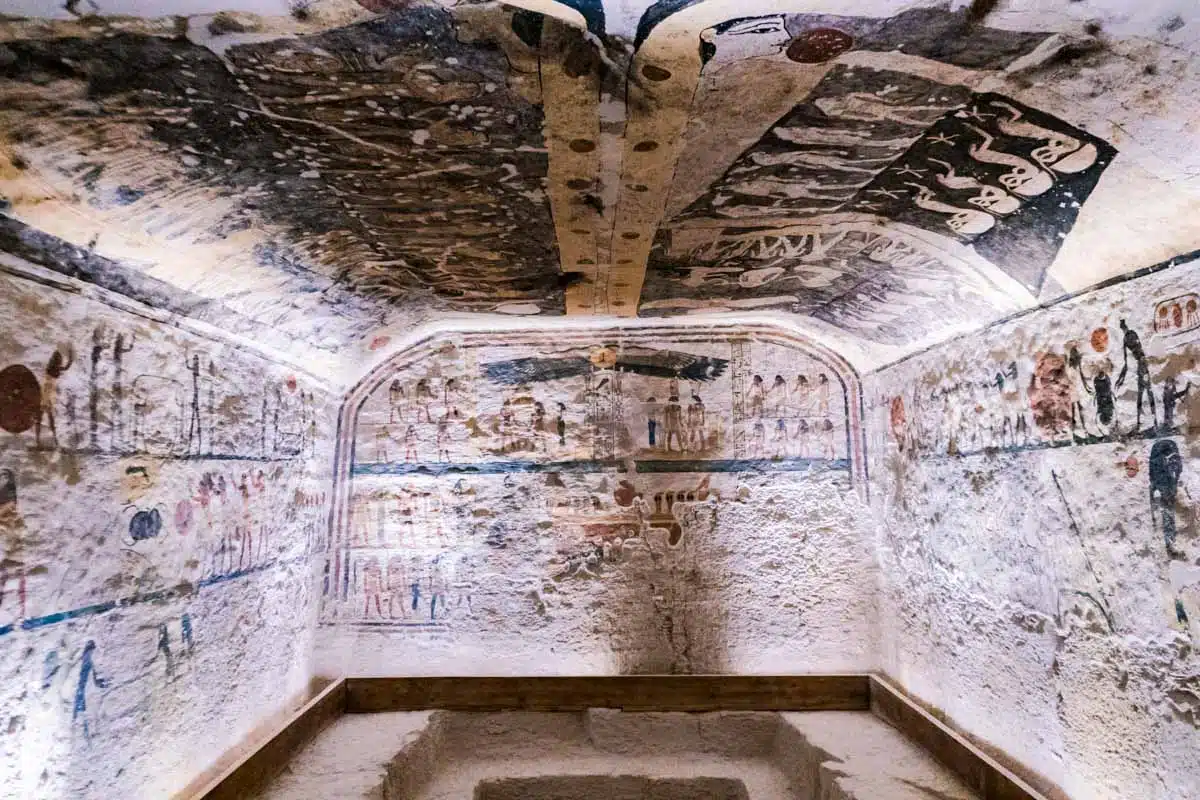
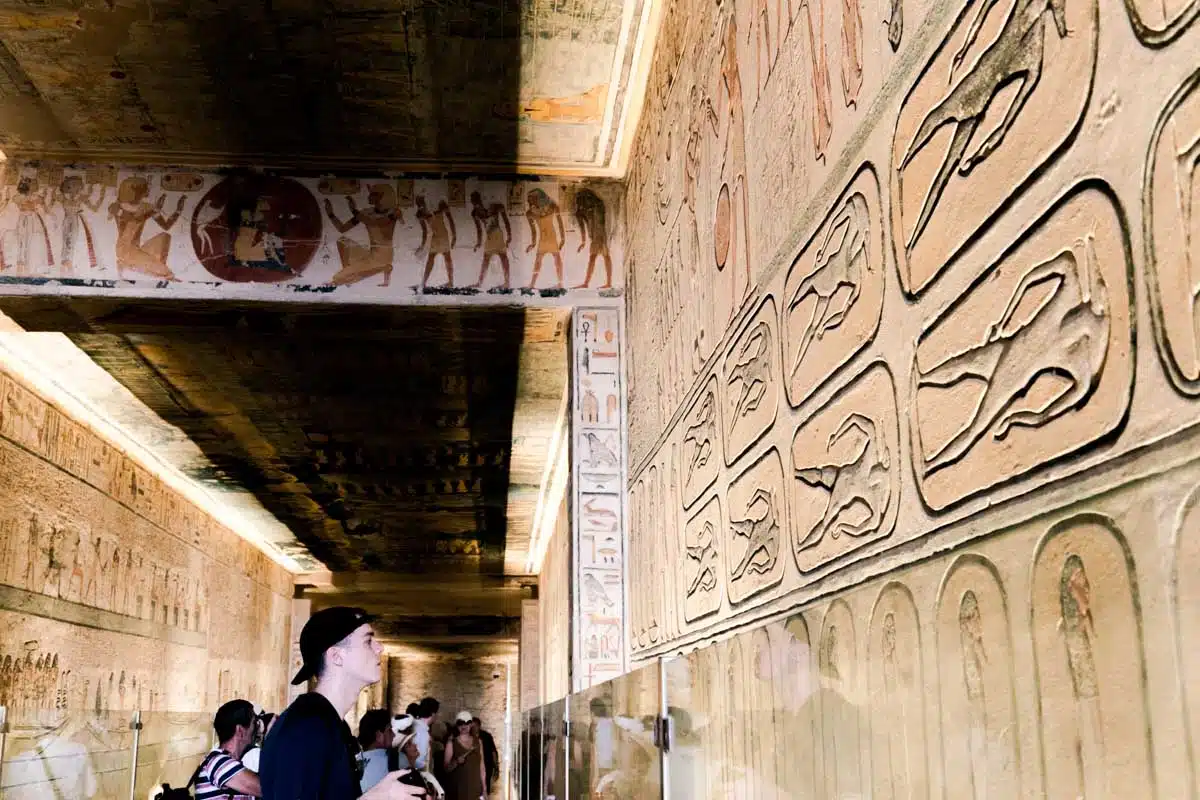
The tomb of Ramses IX is one of the most intricately decorated tombs in the whole valley. It contains various images depicting gods such as Amun, Osiris, and more all along the corridor walls and chambers.
There’s also a short passage that leads up to the burial chamber. The sarcophagus is no longer there, but the walls contain many clues about the pharaoh.
Ramses IV (KV2)
From the outside, a staircase with a ramp takes you to Ramses IV’s tomb entrance. On the entrance door’s lintel are images of the gods Isis and Nephthys worshipping the sun.
You’ll find various paintings and inscriptions as you walk through the corridor leading to the burial chamber. Ramses IV’s granite sarcophagus is inside the burial chamber, covered with inscriptions and reliefs.
Merneptah (KV8)
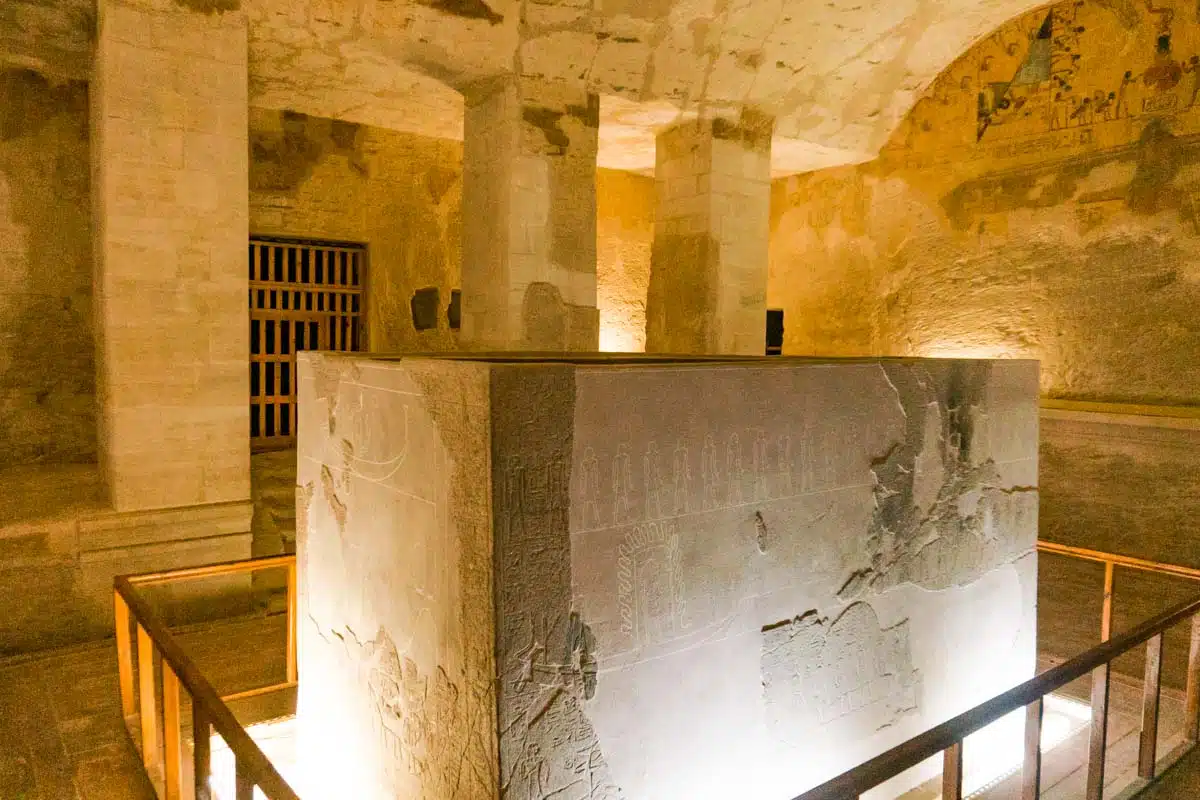
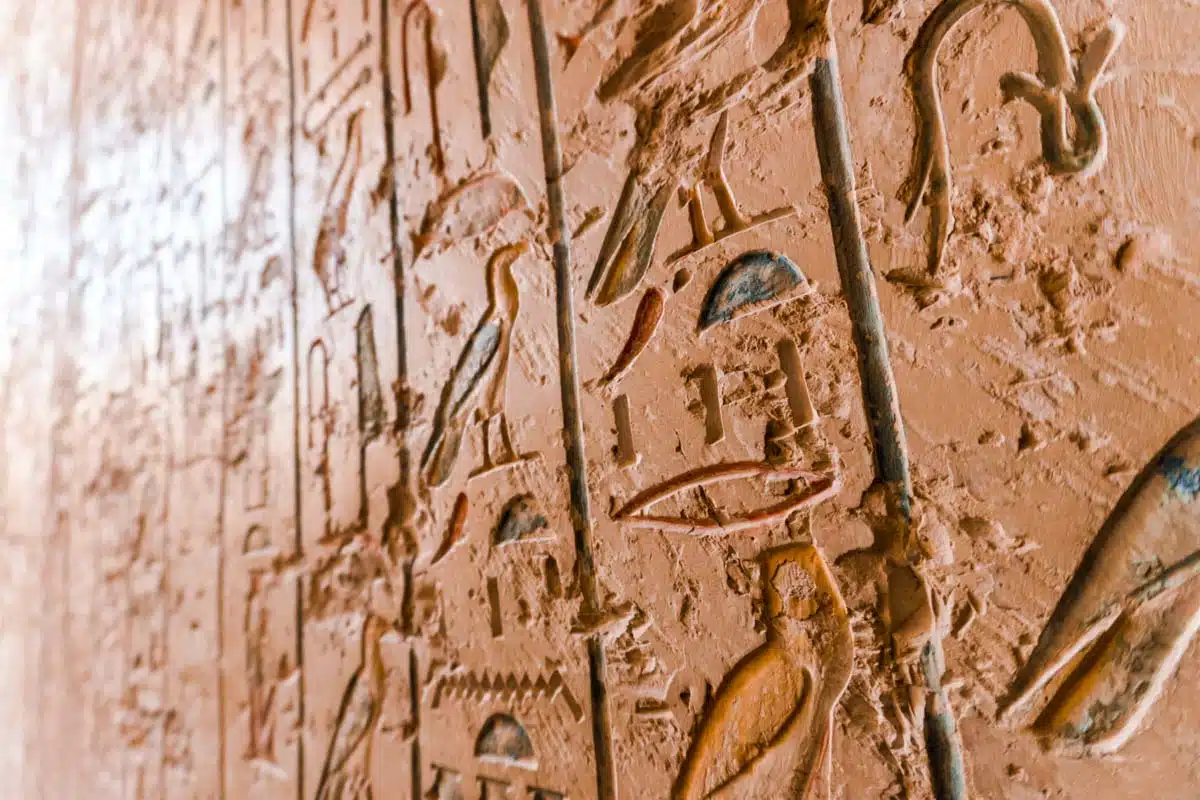
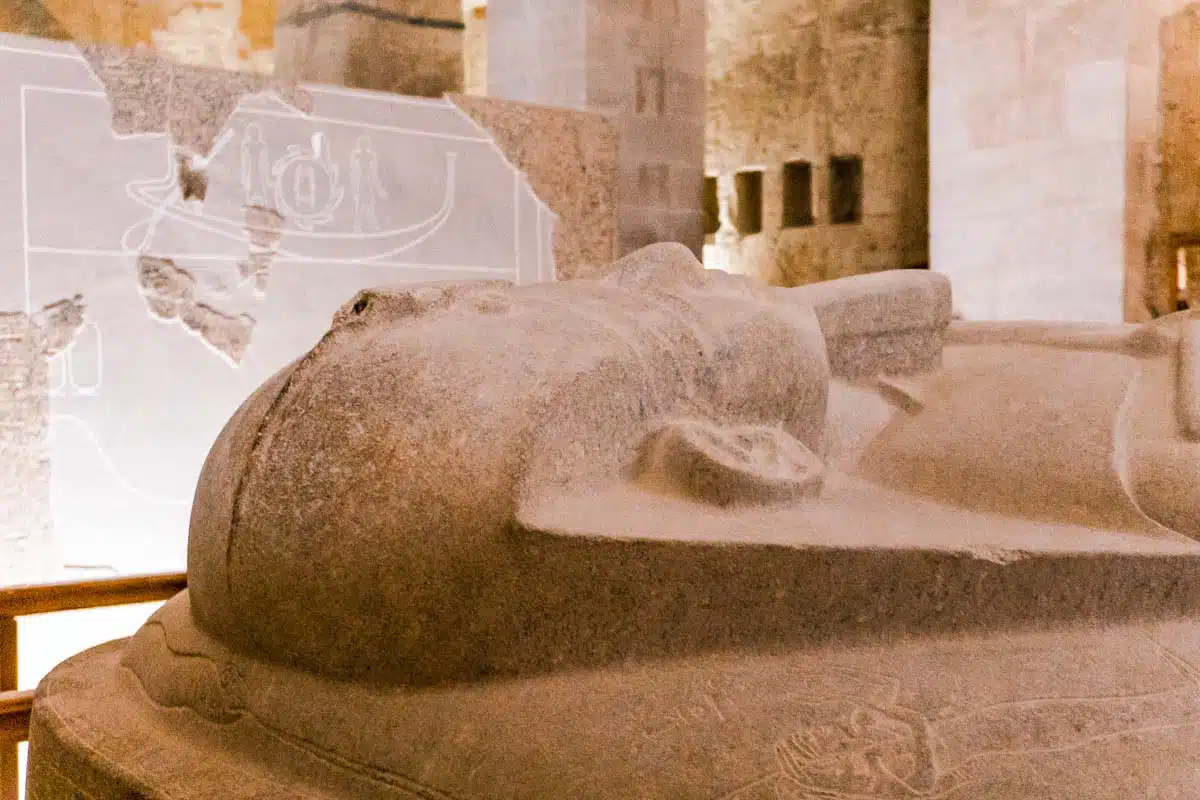
Merneptah’s (or Merenptah) tomb is very long and quite deep, leading to a large burial chamber with a large covered stone sarcophagus inside.
Top Tip
Although it’s relatively simple it does some really beautiful detailing inside – keep an eye out for the scenes from the Book of Caverns, Book of Gates and the Book of the Earth in the Burial Chamber.
Seti II (KV15)
This tomb is right next to Tausert and Setnakht. Archaeologists think that Setnakht built this tomb for Seti II after occupying the other pharaoh’s tomb for himself. Compared to some of the other tombs, this is much smaller and not as decorative.
You can, however, still see fine wall reliefs of images of the god Anubis in the corridor near the entrance. Inside Seti II’s burial chamber, you’ll find his stone sarcophagus intact.
Rameses III (KV11)
One of the largest tombs in the Valley of the Kings, KV11, is the resting place of Rameses III. You enter down long passageways with incredibly detailed artwork, now thankfully protected behind glass, as you walk toward the burial chamber.
These gorgeous sunken, painted reliefs represent several ancient and ritual texts of the age, such as the Litany of Ra and the Book of Gates. These are well worth taking a little time to take in if things aren’t too busy and crowds aren’t pushing you along.
Don’t expect to see the sarcophagus of Rameses III, that’s been removed with the various bits and pieces distributed across the globe. The sarcophagus itself is on display in the Louvre, Paris, while the lid is in the Fitzwilliam Museum in Cambridge, and the mummy is in Cairo’s Egyptian Museum.
Siptah (KV47)
Standing at the southern end of the Valley is KV47, one of the final tombs to be discovered and the burial site of Siptah of the 19th Dynasty.
Although the mummy was actually discovered in KV35, KV47 is another wonderful burial chamber that features stunning wall paintings depicting scenes from Siptah’s journey to the afterlife.
In addition, the tomb illustrates the tumultuous period of the late 12th Dynasty, helping us understand a little more about the history of Ancient Egypt.
Top Tip
The real treat, though, is the sarcophagus, rich in detailed carvings of Egyptian funerals and an insight into their religious and spiritual beliefs.
Tombs You Have to Buy an Extra Ticket For
There are three tombs in the Valley of the Kings that you have to buy an extra ticket for:
- Tutankhamun (300 EGP)
- Seti I (1,000 EGP)
- Ramses V and VI (300 EGP)
I bought a ticket for Tutankhamun, so I have gone into more detail about it below. Seti I’s tomb is also beautiful, but I spent the extra money on seeing Nerfertari’s Tomb in the Valley of the Queens instead. However, there is some more info on those tombs I didn’t see as well.
Tutankhamun (KV62)
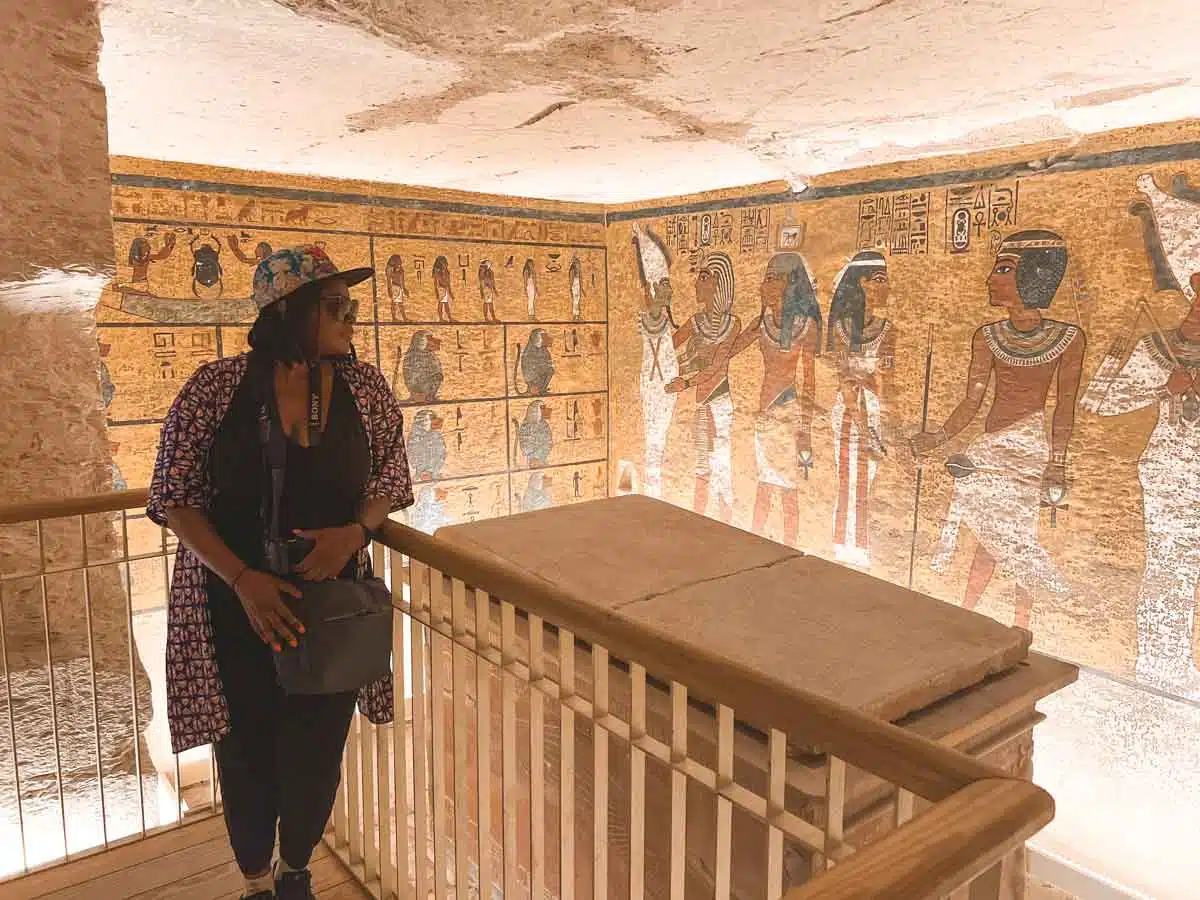
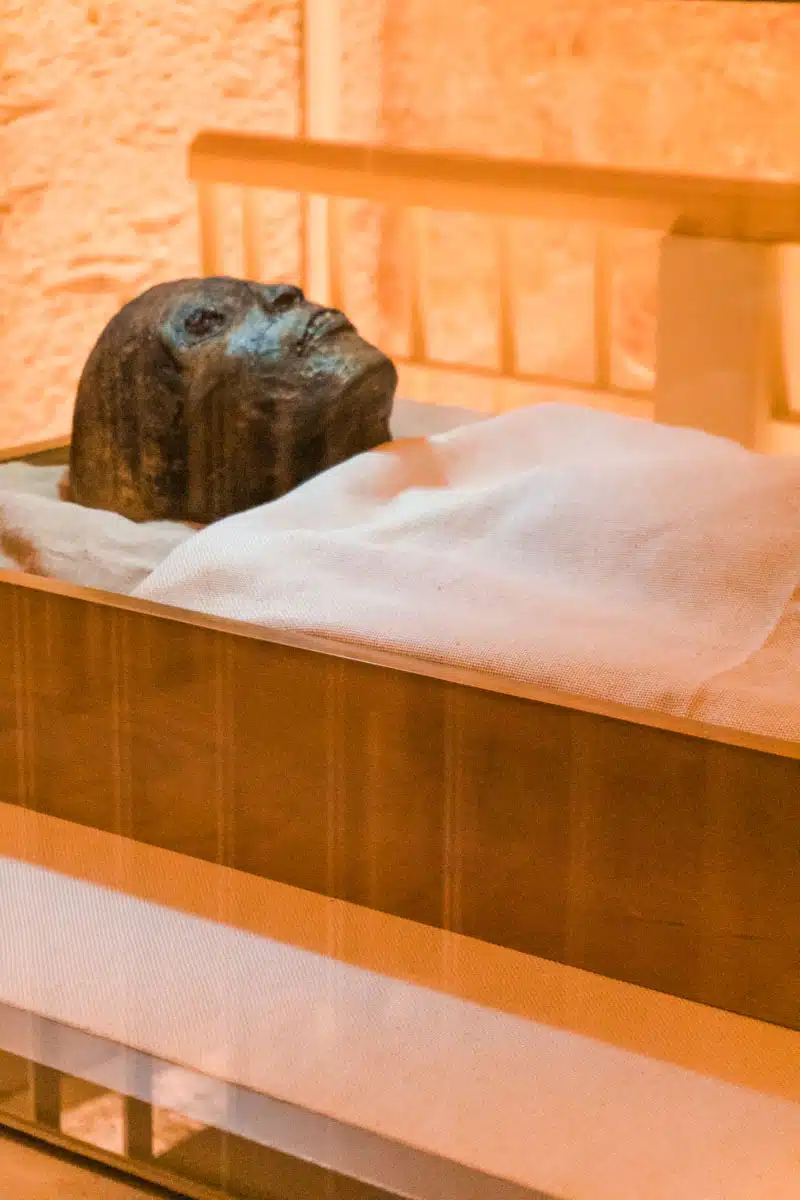
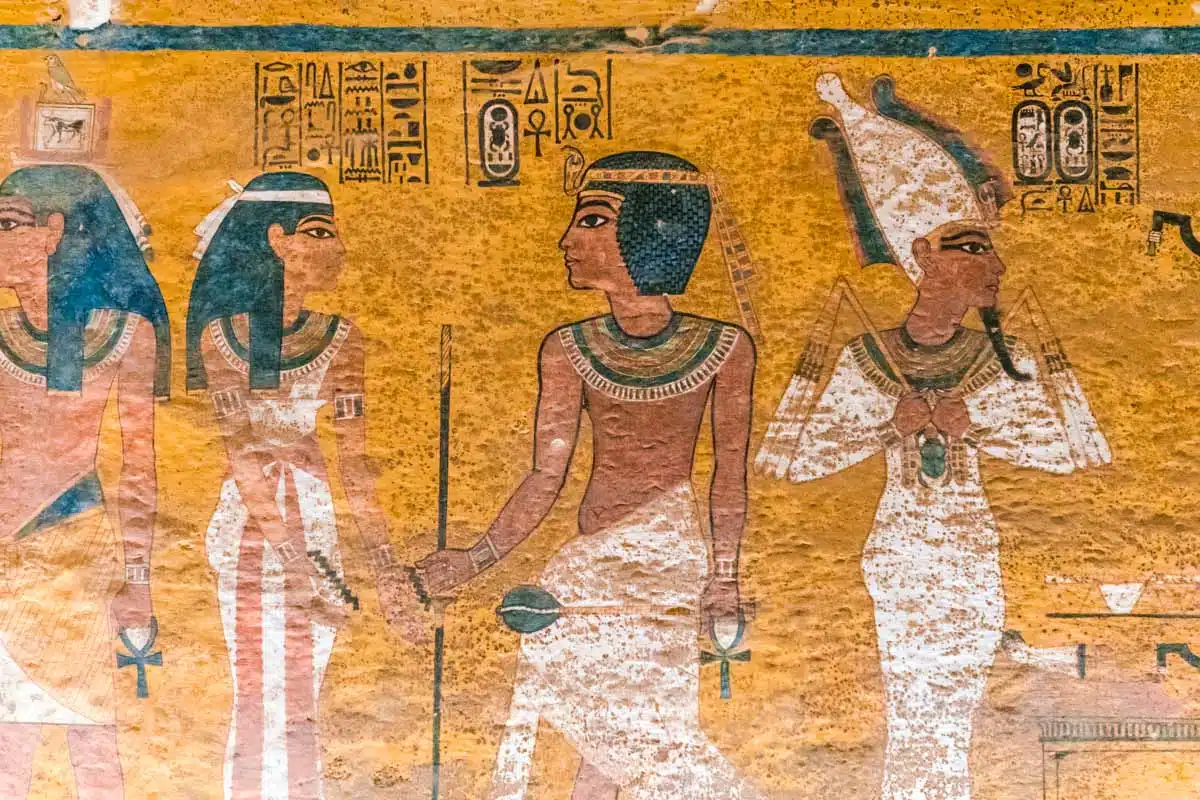
Tutankhamun’s tomb is the most famous in Egypt, discovered by British archaeologist and Egyptologist Howard Carter. It remains one of the most intact tombs, as, at the time of discovery, it still had all of its furnishings and the mummy inside it.
There are 16 stairs that lead down to the entrance of the tomb. From there, it opens up to a narrow passageway about 7.5 metres long. At the far end of the passage, there’s a door leading to an antechamber containing several luxury items.
The main passageway leads to the burial chamber, where Tutankhamun’s mummy is still on display.
Although it’s not the largest tomb in the Valley of the Kings, it is the only one that still has its mummy inside. Plus – it’s the tomb of Tutankhamun! I’d say it’s worth paying the extra money to see.
Tickets
Cost of the extra ticket: 300EGP (this is sometimes reduced to 150EGP during low season)
Seti I (KV17)
One of the deepest tombs in the Valley of the Kings, KV17, the resting place of Seti I, was discovered in 1817 by Giovanni Belzoni and is sometimes known as “Belzoni’s tomb.” As I mentioned above, I chose to visit Nerfertari’s tomb instead, but I’ve heard nothing but good things about this one.
Many consider this to be the most beautiful of all the tombs in the Valley of the Kings, something perhaps reflected in the 1000EGP additional cost, with its long decorated corridors that lead to two vast pillared rooms.
The passageways are adorned with colourful scenes on the wall and a nighttime astronomical scene on the ceiling of the burial chamber. The second room is unfinished, but has sketches of reliefs visible in red and black ink.
The History of The Valley of the Kings
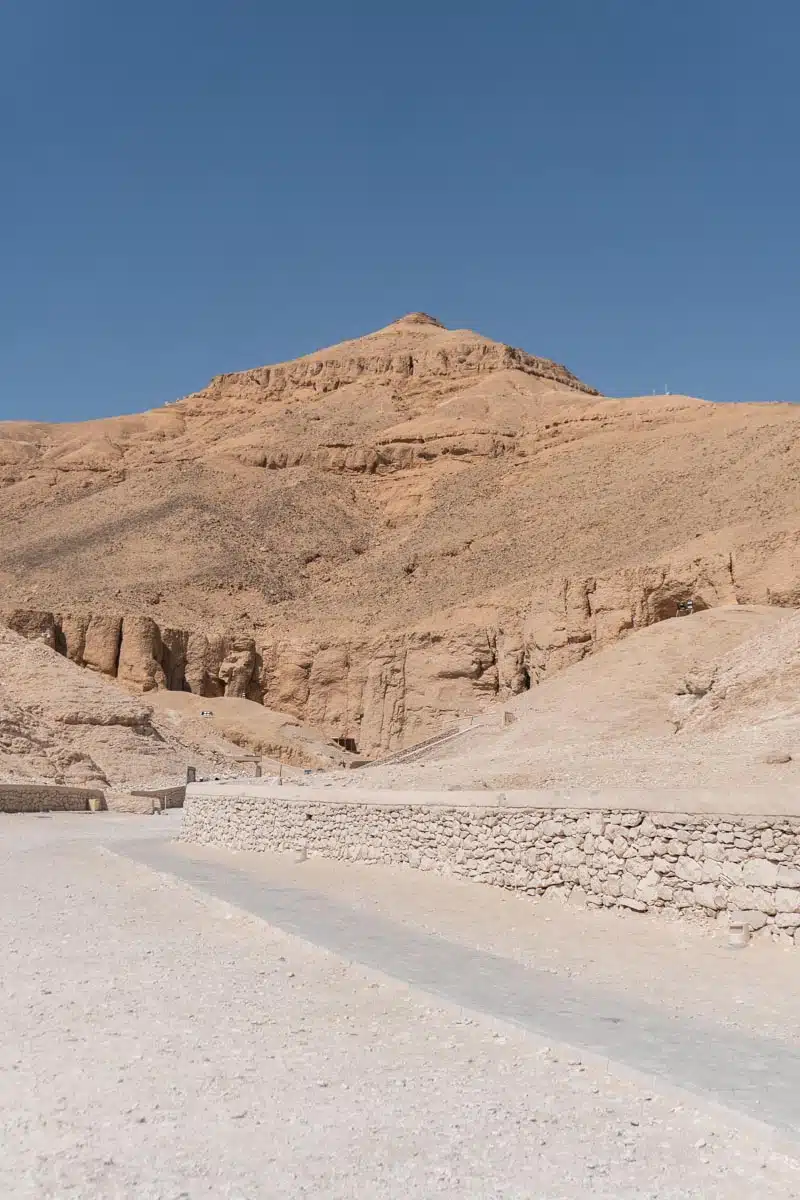
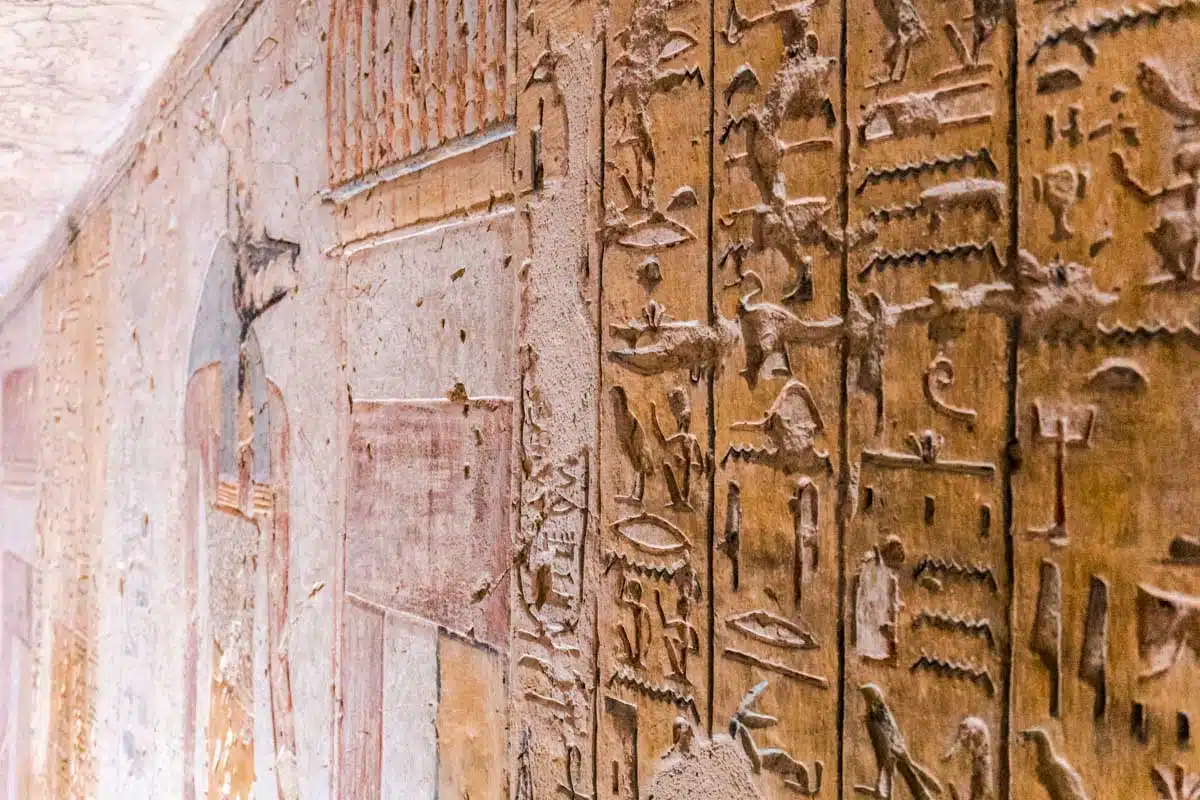
The ancient Egyptians are famous for building impressive monuments to honour their Pharaohs. An example is the Pyramids of Giza, which also acted as burial tombs for their deceased rulers.
Burying pharaohs in pyramids was the custom of the rulers of the Old Kingdom. However, the rulers of the Old Kingdom’s tombs were often vandalised and robbed.
The Tombs of the New Kingdom
So the rulers of the New Kingdom ( 1539 – 1075 BCE) came up with a different plan to protect their mummies and belongings and ensure an undisturbed journey to the afterlife.
Instead they built their tombs in a lonely valley in the West Bank of the Nile across from Luxor (Thebes in ancient times).
These new tombs extended deep into the mountain, making them harder to reach. The Valley of the Kings would also house the tombs of queens and high-ranking officials.
The Plunder of the Valley
Unfortunately, as the power of the Ancient Egyptian civilisation started to wane, the Valley of the Kings was subject to the very same fate as the pyramids of the Old Kingdom – grave robbers.
Many of the tombs were looted during the Twenty-First Dynasty. This led to the priests of Amun opening the tombs and moving the mummies first to a few tombs, and then to a holy place nearby for their protection.
Those mummies were gradually forgotten and remained undiscovered until the 19th century – you can see many of them today in the National Museum of Egyptian Civilisation in Cairo.
Discovery of the Valley
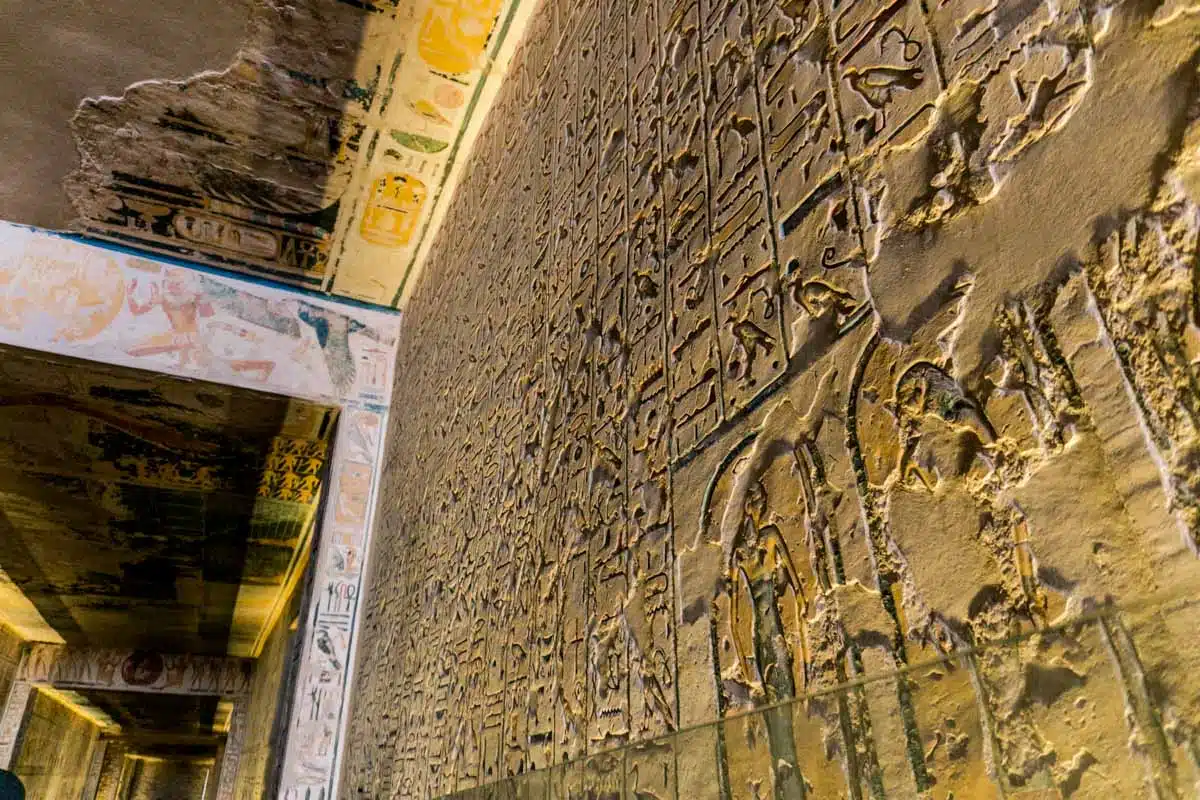
One of the first expeditions to Egypt was undertaken by Napoleon, where members of his party drew maps and plans of tombs that were known, and noted the western valley for the first time.
European exploration grew during the 19th century, notably with Giovanni Belzoni, who worked for the English collector Henry Salt, discovering the temples of Ay (WB23), and Seti I (KV17) in 1816 and 1817 respectively.
Belzoni then declared that all of the tombs had been located, packed up and went home.
In the late 19th century, a renewed effort was made to preserve antiquities and during this period, Victor Loret discovered 16 new tombs in 1898 and 1899 while exploring many of those already discovered.
The remainder of the tombs were discovered in the early 20th century, with the Theodore M. Davis-sponsored team, led by Edward R.Ayrton, discovering several new tombs both of pharaohs and non-royals.
The final discovery was made in 1922 when Howard Carter’s search on behalf of Lord Carnarvon discovered the tomb of Tutankhamun (KV62). Since then, further expeditions have continued to scour the valley.
Top Facts

It was the Burial Ground of the New Kingdom
The Valley of the Kings was the burial place of the rulers of the New Kingdom for around 500 years, spanning over three dynasties.
The First Pharaoh Buried Was…
Tuthmosis I was the first person buried in The Valley of the Kings.
How Many Tombs in the Valley of the Kings?
There are 63 known tombs. However, the site is still an active archaeological site with constant excavations.
The Curse of Tutankhamun

There is an alleged curse on Tutankhamun’s tomb. According to locals, anyone who touches King Tut’s tomb will be cursed for life. This curse stemmed from the fact that some of the members of Howard Carter’s team died mysteriously shortly after discovering the tomb.
KV What?
All the tombs have a number and abbreviation known as “KV.” This stands for King’s Valley.
KV5 is the largest tomb in the valley. Most archaeologists believe that it is the tomb of Ramses II’s sons.
Planning Your Visit to The Valley of the Kings

Visiting The Valley of the Kings on a Tour
An organised tour is the most popular way to visit the Valley of the Kings. These include full-day trips, half-day trips and multi-day trips from other cities. These usually include hotel pick-up and drop-offs, entry tickets to three tombs, and a guide.
Visiting The Valley of the Kings Independently
If you’d like to visit The Valley of the Kings on your own, there are a few ways to do so. If you’re coming from Cairo, it will take about eight hours to get to Luxor, where you’ll find the Valley.
If you’re coming in from Aswan, the journey should only take about three hours. Most people who visit the valley independently can do so by taxi or bus. The drive is about 45-minutes away from Luxor’s city centre.
Ticket Prices for The Valley of the Kings
Once you get there, you’ll have to purchase an entry ticket from the visitor centre.
The entrance ticket costs about 240 EGP (around £10 or $12). This ticket includes the entrance to three tombs, except Tutankhamun, Seti I, and Rameses V and VI’s tombs.
If you’d like to visit any of these tombs additionally, it will cost you:
- 100 EGP (£4) ($5) for both Rameses V and VI’s tombs
- 1000 EGP (£44) ($53) for Seti I
- 300 EGP (£13) ($15) for Tutankhamun
Then there’s a tram you can take to get to the tombs from the visitor centre for 5 EGP (£ 0.22) ( $0.25). There’s also an additional photography pass that you can purchase for 300 EGP (£13) ($15).
Address
Luxor, Luxor Governorate 1340420, Egypt
The Valley of the Kings sits on the West Bank of Luxor, behind the Dayr al-Bahri Hills.
Opening Times
The Valley of the Kings is open all year round from about 6 am to 4 pm in the winter months (November – January) and 5 pm in the summer months (May-August).
Check ahead before you go.
The Valley of the Kings: Map
Read More Luxor Guides
- Incredible Things to do in Luxor
- Visiting the Valley of the Kings
- Why You Should Visit the Valley of the Queens
- The Ultimate Egypt Travel Itinerary
- What You Need to Know to Plan Your Trip to Egypt
- What to Wear + How to Pack for Egypt
- Unmissable Things to do in Egypt
- Egypt Travel Guide and Tips for Your Trip
Love This? Save and Share on Pinterest
